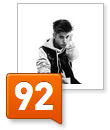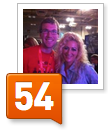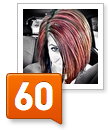Klout Score Formula Insights

 Klout recently changed their Klout scoring algorithm. This was good for some people (my Klout score went from 60 to 81) while disappointing for others; Justin Bieber went from 100 to 92. For those that want to increase their Klout score you really need to understand these new changes. Barack Obama now has the highest Klout Score at 99. Below is a quick summary of the algorithm that produces your Klout Score:
Klout recently changed their Klout scoring algorithm. This was good for some people (my Klout score went from 60 to 81) while disappointing for others; Justin Bieber went from 100 to 92. For those that want to increase their Klout score you really need to understand these new changes. Barack Obama now has the highest Klout Score at 99. Below is a quick summary of the algorithm that produces your Klout Score:
How the Klout Score is Calculated
Klout’s vision is to enable everyone to discover and be recognized for how they influence the world. Klout measures influence based on your ability to drive action on social networks, and has begun to incorporate real-world influence. Klout makes the Web better by providing a standard measurement for content creators to help drive more engaging and relevant content for everyone.
The Klout Score is a number from 1-100 that represents the aggregation of multiple pieces of data about your social network activity.

I was fortunate to be positively impacted by the new Klout Score going from 60 to 81 - Erik Qulaman
Score Signals
The Klout Score currently incorporates more than 400 signals from seven different networks. We process this data on a daily basis to generate updates to your Score.
Here are some of the top signals Klout measures by network:
Facebook:
Mentions: A mention of your name in a post indicates an effort to engage with you directly.
Likes: The simplest action that shows engagement with the content you create.
Comments: As a reaction to content you share, comments also reflect direct engagement by your network.
Subscribers: Subscriber count is a more persistent measure of influence that grows over time.
Wall Posts: Posts to your wall indicate both influence and engagement.
Friends: Friend count measures the reach of your network but is less important than how your network engages with your content.
Retweets: Retweets increase your influence by exposing your content to extended follower networks.
Mentions: People seeking your attention by mentioning you is a strong signal of influence. Klout also takes into account the differences in types of mentions, including “via” and “cc”.
List Memberships: Being included on lists curated by other users demonstrates your areas of influence.
Followers: Follower count is one factor in your Score, but Klout heavily favors engagement over size of audience.
Replies: Replies show that you are consistently engaging your network with quality content.
Google+
Comments: As a reaction to content you share, comments also reflect direct engagement by your network.
+1′s: The simplest action that shows engagement with the content you create.
Reshares: Reshares increase your influence by exposing your content to extended networks on Google+.
Title: Your reported title on LinkedIn is a signal of your real-world influence and is persistent.
Connections: Your connection graph helps validate your real-world influence.
Recommenders: The recommenders in your network add additional signals to the contribution LinkedIn makes to your Score.
Comments: As a reaction to content you share, comments also reflect direct engagement by your network.
foursquare
Tips Done: The number of suggestions you’ve left that have been completed indicate your ability to influence others on foursquare.
Klout
+K received: Receiving +K increases your Klout Score by an amount that is capped in every 90-day measurement cycle to protect the integrity of the Score.
Wikipedia
Page Importance: Measured by applying a PageRank algorithm against the Wikipedia page graph.
Inlinks to Outlinks Ratio: Compares the number of inbound links to a page to the number of outbound links.
Number of Inlinks: Measures the total number of inbound links to a page.
The majority of the signals used to calculate the Klout Score are derived from combinations of attributes, such as the ratio of reactions you generate compared to the amount of content you share. For example, generating 100 retweets from 10 tweets will contribute more to your Score than generating 100 retweets from 1,000 tweets. We also consider factors such as how selective the people who interact with your content are. The more a person likes and retweets in a given day, the less each of those individual interactions contributes to another person’s score. Additionally, we value the engagement you drive from unique individuals. One-hundred retweets from 100 different people contribute more to your Score than do 100 retweets from a single person.
We know how important it is to maintain the integrity of the Klout Score, so we closely monitor activity across the signals we measure for inauthentic behaviors. The Score will continue to evolve and improve as we add more networks and more signals.
Measuring Real-World Influence
The Klout Score now includes sources that indicate real-world influence, with Wikipedia as a new primary data source. Wikipedia is curated and maintained by millions of people worldwide, enabling us to incorporate a democratic signal of influence. We calculate the importance of each Wikipedia page, and integrate these signals with the rest of a user’s signals to compute their Klout Score. We determine Wikipedia “page importance” by running a PageRank algorithm on the Wikipedia graph, as well as factoring the number of inbound links and outbound links to each page.
Core Concepts
Now that you know what information goes into Klout, here are the principles that guide the Klout Score.
Influence is the Ability to Drive Action
It’s great to have lots of connections, but what really matters is how people engage with the content you create. We believe it’s better to have a small and engaged audience than a large network that doesn’t act respond to your content.
Connecting Networks Can Only Help Your Score
We want to help you understand your influence wherever it may exist. We also understand, given the number of different networks out there, that it is nearly impossible for any person to be consistently effective across every network. Adding more networks helps us more accurately measure your influence and can only increase your Score.
Everyone has Klout
You are never penalized for connecting or engaging with someone with a low Klout Score. In fact, you are helping build their Klout Score. The more influential you are, the greater impact you have. All engagement positively contributes to your Score.
Influence is Built Over Time
In most instances, your influence should not radically change from one day to the next. The Klout Score is based on a rolling 90-day window, with recent activity being weighted more than older activity. Being inactive over the weekend or taking short break won’t have a major impact on your Score, but if you’re inactive for longer periods your Score will decrease gradually.
Being Active is Different than Being Influential
Retweets, Likes, comments and other interactions on the social Web are all signals of influence. However, just looking at the count of these actions does not tell the whole story of a person’s influence. It’s important to look at how much content a person creates compared to the amount of engagement they generate.
Klout is Constantly Evolving
The social Web is changing every day and the Klout Score will continue to evolve and improve. The best strategy for obtaining a high Klout Score is to simply create great content that your network wants to share and engage with.
A Closer Look at the Klout Score
Check how these users were impacted by the recent Score model update.

Barack Obama
Barack Obama has an active Twitter profile, and also has the most important Wikipedia page among all individuals. The addition of real world influence causes his score to rise from 94 to 99 in the updated Score model. See profile

Justin Bieber
Although Justin Bieber is one of the most influential celebrities on Twitter, his Wikipedia page has lower importance than those of people like Barack Obama. Previously, Justin had the distinction of being the only person with a perfect 100 Klout Score. With this update, his Score drops from 100 to 92.See profile

Jacob Barrett
Jacob’s Klout Score increased because we are measuring more signals, such as Facebook mentions, and we have included better scoring for networks like LinkedIn. Nearly 71 percent of his Score comes from Facebook, and around 3.5 percent from LinkedIn. See profile

Ashleigh Stephan
Ashleigh is primarily a Facebook user, with more than 97 percent of her Score coming from that network. Again, the addition of new signals on Facebook means that we now capture more of her influence, so her Score increases. See profile

Erica Stine
Erika is active on both Facebook and Twitter. She gets 70 percent of her Score from Facebook and 22 percent from Twitter. She also benefits from +K (7 percent). See profile

Shanna Bailes
Shanna is equally active on Facebook and Twitter, and thus benefits from new signals captured from both. See profile
[image error]




